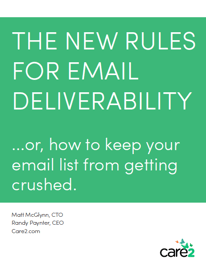At Care2, we spend a lot of time thinking about email deliverability.
Why? Because organizations can have the best email marketing strategy, endless budget, and the most engaged subscribers of all time and they still won't reach their goals if their emails are marked as spam.
It sounds easy: just make sure you aren't spamming people, right?
In reality, the increasingly restrictive policies of your Internet Service Providers make it impossible to continue with mailing practices that worked a few years ago. And if you don't keep up with these changing practices, the penalties are severe.
Campaigns could be delivered to the “spam” box, even for your best subscribers.
Third-party blacklist operators could red flag your outbound mail server IP addresses. This can cause many ISPs to reject your incoming mail, long before your subscribers see it.
ISPs could apply a penalty, causing 100% of your messages to be delivered to the “spam” box.
And it could take months to recover.
The best time to prevent these problems is now, which is why we've compiled all our extensive knowledge on the subject into Care2's latest white paper, The New Rules for Email Deliverability.
Please enjoy this short excerpt from our new guide, and download the full white paper here.
Today’s “best practices” result largely from two specific, relatively recent changes in the industry. Neither of these were true 10 years ago, but both are true today:
- Some email addresses are toxic.
- Formerly good addresses can become toxic.
It used to be true that a few bad addresses wouldn’t affect the inbox rates for the rest of the campaign. Those days are over. Now it is possible that a few bad addresses can destroy the reputation of your brand and your outbound mail IP addresses in the eyes of the ISPs who host all of your subscribers’ inboxes. Sender reputation problems due to toxic addresses could cause a 20- 100% drop in inbox rates overnight.
Unsubscribe all the obviously bad addresses.
This can be a relatively quick process. Remove all non-deliverable, obfuscated, and temporary addresses, the role accounts, the dead and typo domains.
Chances are, none of those subscribers have ever received your emails anyway, so there is literally no loss to the business — but potentially some significant gains — when you delete them.
Purge lapsed and inactive subscribers.
The idea is simple, but the implementation of this is admittedly challenging, both for technical and political reasons. The goal is to remove subscribers who are no longer actively engaged with your email and/or your organization.
It is possible that the population of lapsed/inactive subscribers contains a disproportionately high percentage of complainers. Further, if you have never purged inactives, it is very likely that this segment of your list contains converted spamtrap addresses. Finally, every non-engaged subscriber is dragging down your Sender Reputation metrics. Therefore it is critical that these low-value, high-risk addresses are purged regularly.
Download the white paper to read more, including instructions on detecting and blocking bad email addresses and tips to improve deliverability for your design and content teams.



COMMENTS